
Are you preparing for a job interview and want to increase your chances of success? Understanding job interview statistics can help you prepare and make a positive impression on potential employers. In this article, we’ll delve into the latest job interview statistics and provide you with valuable insights to help you ace your next interview.
Job Interview Statistics (Editor’s Pick)
- Submitting five to ten applications per week increases the likelihood of landing an interview.
- 92% of companies use social media platforms to research candidates before an interview.
- 36% of employers look for multitasking skills in candidates.
- 47% of interviewers said that they wouldn’t offer the job to a candidate if they had little knowledge of the company.
- 33% of interviewers knew whether they would hire someone within the first 90 seconds of an interview.
- 76% of recruiters will pass on a candidate they perceive as overly arrogant.
- The entire interview process usually spans about 23 days.
- 73% of candidates are passive job seekers.
- 88% of companies believe referrals result in the best hiring outcomes.
- A substantial 90.6% of employers prefer candidates with work experience.
- The average time spent looking at a resume is 5-7 seconds.
- Nearly half (47%) of interviewers would not hire a candidate lacking knowledge about the company.
- Typos or lousy grammar are immediate deal breakers for 77% of recruiters, and 35% reject candidates with unprofessional email addresses.
- Only 41% of candidates receive feedback after an interview, though 94% expect it.
General Job Interview Statistics
- A large majority (90.6%) of employers prioritize candidates with work experience. (Source)
- Nearly half of interviewers refuse to hire candidates who lack an understanding of the company. (Source)
- A significant majority (81%) of job seekers admit to lying during interviews. (Source)
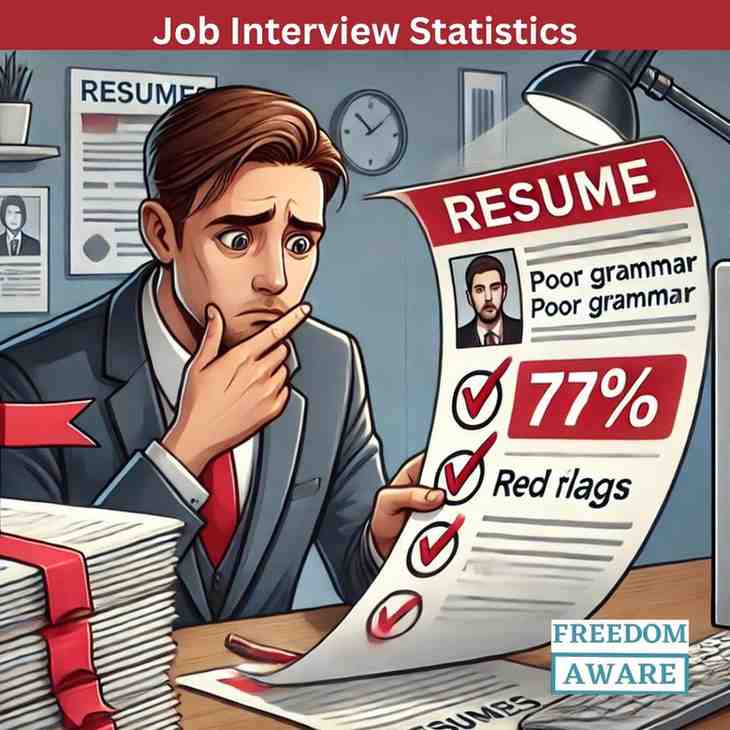
- Typos or poor grammar are red flags for 77% of recruiters. (Source)
- 35% reject candidates with unprofessional email addresses. (Source)
- In-person interviews typically last between 45 and 90 minutes, depending on the tasks or presentations involved. (Source)
- Impressed candidates may receive job offers within 24-48 hours. (Source)
- 60% of recruiters incorporate video interviews into their hiring process. (Source)
- When hiring, employers primarily value multitasking (36%), followed by initiative (31%), creative thinking (21%), and other skills (12%). (Source)
- Employers typically spend only 5-7 seconds glancing at a resume. (Source)
- For every job, an average of 118 people apply, but only about 20% receive interviews. (Source)
- The majority of candidates (92%) believe mock interviews are crucial preparation. (Source)
- A positive interview experience is more likely (52%) when candidates are informed about the next steps. (Source)
- Only one in four candidates reported having an excellent interview experience. (Source)
- Nearly 80% of job candidates find video interviews more difficult or stressful compared to in-person interviews. (Source)
- Applicants with white-sounding names were 50% more likely to be contacted for job interviews than those with typical black names. (Source)
- Nearly 62% of candidates don’t receive any information about the interview beyond the date and location. (Source)
- Face-to-face interviews usually last 40 minutes, while phone interviews are shorter, averaging 30 minutes. (Source)
- While 44% of candidates hear back within a few weeks and 37% within a week, only a small percentage (less than 4%) receive feedback within a day. (Source)
- Typically, only 2% of job applicants are invited for interviews. (Source)
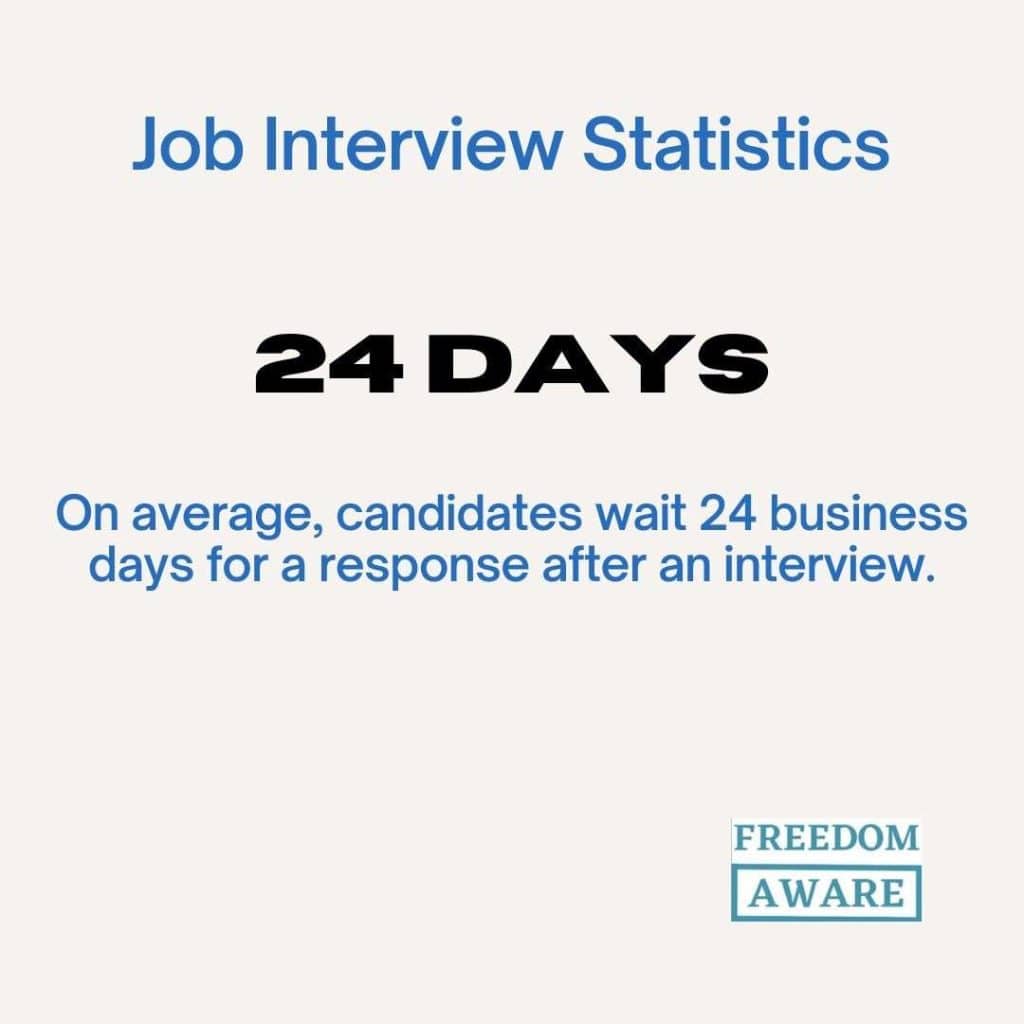
- On average, candidates wait 24 business days for a response after an interview. (Source)
- Men exhibit 33% more confidence in their interview performance compared to women. (Source)
- The average hiring process in the U.S. has slightly lengthened from 22.9 days in 2014 to 23.8 days currently. (Source)
- A positive interview experience significantly influences job acceptance, with 76% of candidates more likely to accept offers. (Source)
- Nearly half of the candidates(45%) who ghost employers do so after the interview. (Source)
- In the UK, candidates spend an average of £52 on travel and accommodation for interviews. They also invest about £58 in new interview attire. (Source)
- A significant number of candidates (53%) have been ghosted by employers, with 31% being ghosted after a positive response but before scheduling an interview. (Source)
- To improve their chances, 95% of people attempt to appear younger during job interviews. (Source)
- Age discrimination is prevalent in various industries, with finance, advertising, and digital marketing reporting rates of 85%, 84%, and 81%, respectively. (Source)
- A large majority (75%) of U.S. employees have experienced ageism during job hunting, and over half (53%) continue to experience it in their current jobs. (Source)
- Organizations often use competency-based questions to assess candidates’ skills. (Source)
- Only 41% of candidates receive feedback after interviews, despite 94% expecting it. (Source)
- A significant 93% of people feel anxious about job interviews. (Source)
- Nearly 40% of applicants don’t receive an interview despite applying to ten jobs. (Source)
- On average, white job applicants received 9.5% more interview offers than assumed black applicants. Additionally, the worst-performing companies, often in the car industry, interviewed 23% more assumed white applicants than assumed black applicants. (Source)
- Women are 30% less likely than men to be called for interviews, even with identical qualifications. (Source)
- A study shows that women without children are 23.5% less likely to receive interview calls than men in similar circumstances. (Source)
- Women with children are 35.9% less likely to be called for interviews than fathers. (Source)
Insights into Job Interview Procedures (Job Interview Statistics)
- A study revealed that 33% of hiring managers make hiring decisions within 90 seconds. (Source)
- A 50-year-old worker is up to three times less likely to get an interview than a 28-year-old. (Source)
- Applicants submitting 21-80 applications have a 30% chance of receiving an offer. (Source)
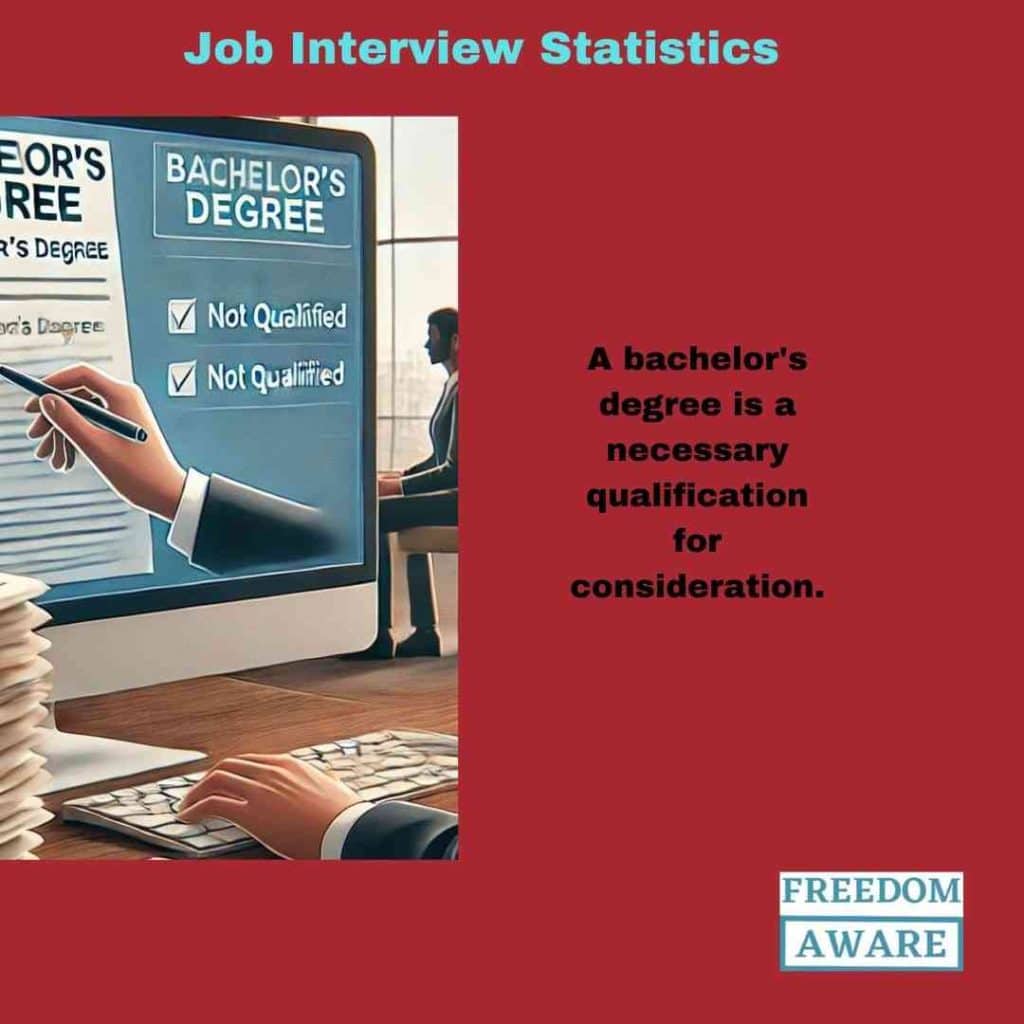
- For nearly one-third of job listings, a bachelor’s degree is a necessary qualification for consideration, excluding those without it from the interview process. (Source)
- Lengthy application processes lead to 60% of applications being abandoned. (Source)
- Utilizing specialized recruiting platforms can reduce cost-per-applicant by 250%. (Source)
- Candidates typically receive one interview offer for every six applications submitted. (Source)
- 76% of CVs are rejected due to unprofessional email addresses. (Source)
- 51% of recruiters find the best candidate after conducting three interviews. (Source)
- Even for non-technical roles, companies with over 5,000 employees take an average of 58 days to make offers. (Source)
- The typical interview process consists of five stages, a common practice across most companies. (Source)
- Responsiveness during the hiring process is increasingly valued, especially in the UK (52%) and US (56%), compared to previous years. (Source)
First Impressions in Job Interviews (Job Interview Statistics)
- 55% of employers prefer smart-casual attire, while 19% have no dress code, and 26% require formal interview attire. (Source)
- 59% of recruiters reject arrogant candidates, emphasizing the importance of humility and teamwork. (Source)
- A vast majority, 95%, place significant importance on first impressions, and a large proportion, 79%, are convinced of their skill in creating a favorable one. (Source)
- 39% of job seekers leave a bad impression due to confidence issues, voice quality, or lack of a smile, highlighting the significance of nonverbal cues. (Source)
- 60% of interviewers form an opinion about a candidate within the first 15 minutes. (Source)
- Managers are less likely (65%) to select candidates who avoid eye contact and may consider (40%) a candidate’s voice as a dealbreaker. (Source)
- 67% of recruiters believe eye contact is crucial for establishing a good impression. (Source)
- 55% of recruiters base their decisions on handshakes, while a candidate’s smile influences 40%. (Source)
- Half of all managers judge candidates based on clothing and behavior before the interview even begins. (Source)
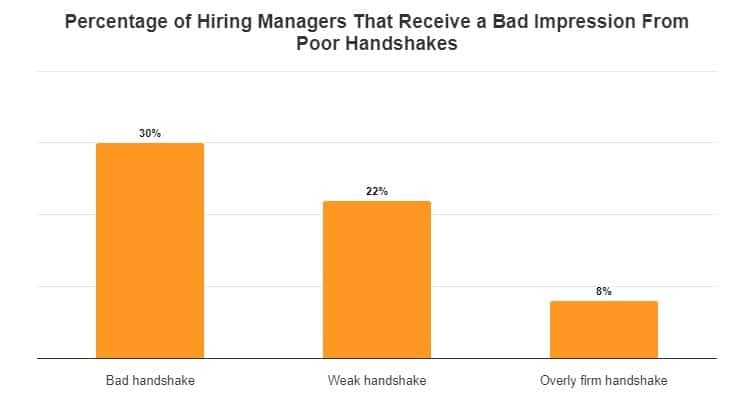
- A limp handshake can be a red flag for recruiters, with 30% stating it diminishes a candidate’s perceived impressiveness. (Source)
- 68% of employees believe the applicant experience reflects the company’s treatment of its employees. (Source)
- Candidates have only 7 seconds to make a positive first impression during a job interview. (Source)
- 69% of job interviewers formed a first impression before the candidate spoke, and 83% were more positive about someone who appeared self-confident. (Source)
- The tone of someone’s voice matters to 38% of people when they’re forming a first impression. (Source)
Job Hiring Processes (Job Interview Statistics)
- Nearly 90% of candidates exit the hiring process due to misalignments between the company’s employee value proposition and their own expectations. (Source)
- The average cost per hire has increased from $4,129 in 2019 to $4,700, representing a 14% rise. (Source)
- In France, personal contact is crucial for 54% of candidates in the hiring process, compared to 53% in Germany, 29% in the UK, and only 18% in the US. (Source)
- 52% of job seekers declined job offers due to negative experiences. (Source)
- The average time-to-hire across industries is three to four weeks, with only 25% of respondents filling roles in less than two weeks. (Source)
- 48% of businesses find their top-quality hires through employee referrals. (Source)
- Approximately 90% of employers review candidates’ social media profiles, and 79% have rejected applicants based on their findings. (Source)
- 98% of businesses conduct background checks on applicants, with 43% using Google. Additionally, 80% of businesses consider a personal website important in candidate evaluation. (Source)
- 63% of recruiters cite finding enough suitable candidates as their biggest challenge. (Source)
- Corporate-level roles attract an average of 250 applications, with top candidates often interviewing with multiple companies simultaneously. (Source)
- 61% of interviewers and employers believe 9:00 a.m. and 11:00 a.m. are the best times for interviews due to optimal alertness and responsiveness. (Source)
- Employers emphasizing diversity in their job postings receive 26% more applications from women. (Source)
- Companies with ethnically diverse boards are 13% more likely to outperform those with less diversity. (Source)
- Millennials and Gen Z will make up 75% of the global workforce by 2025. (Source)
Behaviors of Recruiters During Job Interviews (Job Interview Statistics)
- 74% of human resources professionals use structured interview techniques to assess candidates systematically. (Source)
- Behavioral interviews, which focus on past behaviors to predict future performance, are used in 73% of cases. (Source)
- Phone screening, often used as an initial step in candidate assessment and screening, is utilized by 57% of recruiters. (Source)
- Panel interviews, involving multiple interviewers assessing a candidate simultaneously, are utilized by 48% of HR professionals. (Source)
- A survey found that hiring managers spend between 30 minutes and 2 hours scheduling a single interview. (Source)
- According to a survey, 25% of recruiters consider long paragraphs of text instant dealbreakers, while 17% say the same about resumes exceeding two pages. (Source)
Technology In Job Interviews (Job Interview Statistics)
- 79% of hiring managers now use video technology to interview and evaluate candidates, a substantial increase from previous years. (Source)
- About 25% of job seekers prefer live video interviews over in-person ones. (Source)
- 51% of recruiters utilize automated interview scheduling tools to streamline the process and improve efficiency. (Source)
- Approximately 97.4% of Fortune 500 companies use application tracking software. (Source)
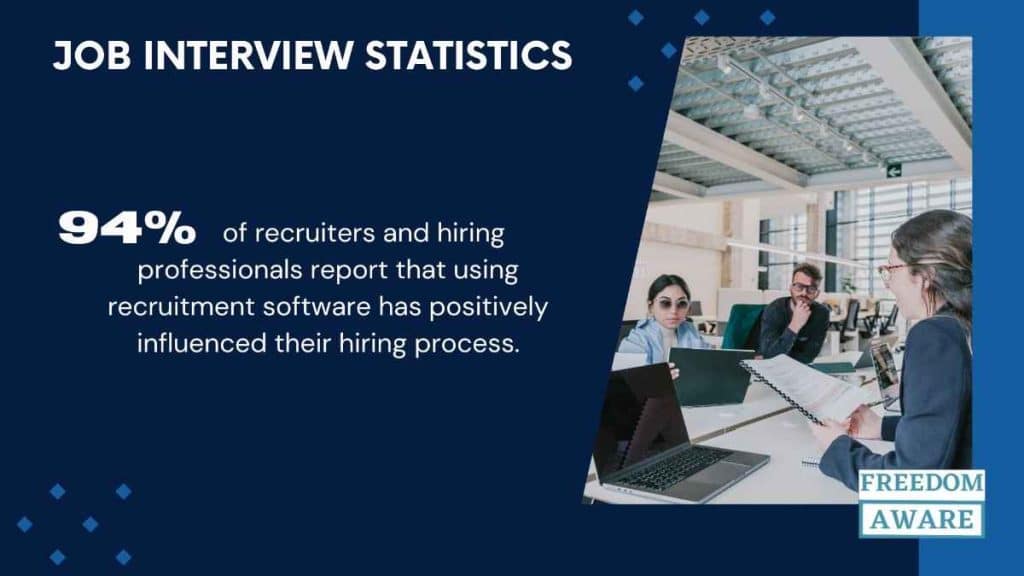
- 94% of recruiters and hiring professionals report that using recruitment software has positively influenced their hiring process. (Source)
- A LinkedIn survey indicates that 81% of talent professionals and recruiters believe virtual recruiting will continue post-Covid. (Source)
- A recent Indeed survey found that 82% of employers use virtual interviews, and 93% plan to continue using them. (Source)
- Only 46% of HR professionals in the U.S. feel prepared to adapt to virtual recruiting. (Source)
- SBAM reports a 49% increase in the popularity of online job interviews since 2011. (Source)
- From 2019 to 2023, the use of video interviews shot up by 57%. (Source)
- In 2024, 69% of employers intend to use video interviews in their hiring process. (Source)
Interview Success and Failure Analysis (Job Interview Statistics)
- Many studies have shown that companies are more hesitant to hire individuals who are currently unemployed. (Source)
- Job seekers with bachelor’s degrees were significantly more likely to go through interviews without offers compared to those with only a high school diploma, with 51% and 35% respectively. (Source)
- A significant number of recruiters, 60%, report losing potential candidates before they can even schedule an interview. (Source)
- The recruitment process faces a high failure rate of approximately 50%, which is a major problem at all job levels. (Source)
- Employers believe that the majority of job applications, around 75%, are from candidates who are not qualified for the position. (Source)
- In the United States, a much higher percentage of job candidates, 67%, are willing to wait six days for an interview compared to their counterparts in Germany, the UK, and France. (Source)
Key Interview Trends for 2024 (Job Interview Statistics)
These trends demonstrate a move toward more streamlined, tech-centric, and competency-based hiring practices, with a strong focus on retaining top talent.
- Virtual Recruitment
The shift to remote work has led to a dramatic increase in virtual recruiting practices. Many companies have embraced virtual recruiting and onboarding, with some adopting fully virtual processes. It’s imperative that virtual recruiting effectively communicates a company’s culture from the start. Recruiters are key in developing strategies for finding, training, and retaining employees, and virtual recruiting is playing an increasingly important role in this process. By allowing companies to reach a broader pool of qualified candidates, virtual recruiting opens up new opportunities and improves the overall recruitment process for many organizations.
- Soft Skill Assessment
Soft skills are gaining significant attention from employers. While technical skills are still valued, interviewers are now more intentional about observing and assessing soft skills during interviews. They are looking for communication, teamwork, adaptability, and problem-solving abilities. Many job interviews now include personality and behavioral tests to properly measure a candidate’s capabilities and identify the top performers. Startups and small businesses, especially, need to evaluate soft skills when interviewing job candidates.
- Branding on Social Media
Employers are increasingly checking potential candidates’ social media profiles. This means that job seekers should be intentional about presenting a clean and professional image on their social media platforms.
- Diversity And Inclusion
Companies are prioritizing diversity and inclusion more than ever before. Employers are actively striving to build more diverse teams and create inclusive workplaces. This is not only the right thing to do but also makes good business sense. Diverse teams are more innovative, better reflect the diversity of their customers, and have higher employee satisfaction. Cultivating a culture of respect, empathy, and understanding is crucial.
- AI in Recruitment
AI is becoming a more prominent part of the recruitment process. Machines can now analyze resumes, cover letters, social media profiles, and video interviews to identify top candidates. This saves recruiters time and effort, allowing them to focus on the more strategic aspects of hiring. But AI must be used in conjunction with human judgment. We don’t want to end up with a completely automated hiring process that lacks the personal touch that humans bring to the table.
How to Stand Out in an Interview (Job Interview Statistics)
To make a memorable impression in an interview, consider these tips:
Before the Interview
- Research the company: Understand its mission, values, and recent news.
- Practice your answers: Prepare for common interview questions and practice your responses.
- Dress appropriately: Choose professional attire that reflects the company culture.
- Arrive early: Aim to arrive 10-15 minutes early to show punctuality.
During the Interview
- Make a strong first impression: Greet the interviewer with a firm handshake and eye contact.
- Be enthusiastic and engaged: Show genuine interest in the company and the role.
- Highlight relevant skills and experiences: Tailor your answers to demonstrate how your skills align with the job requirements.
- Ask thoughtful questions: Show your interest by asking insightful questions about the company, the role, and the team.
- Follow up: Send a thank-you email within 24 hours, reiterating your interest in the position.
Most importantly don’t forget to be yourself, be positive, and show confidence.

Conclusion (Job Interview Statistics)
The job interview process can be intimidating, but understanding these statistics can equip you with valuable insights and tips. By preparing thoroughly, presenting yourself confidently, and demonstrating your qualifications and enthusiasm, you can increase your chances of success and land your dream job.
FAQ (Job Interview Statistics)
- What is a good number of interviews?
The ideal number of interviews can vary depending on individual circumstances and the specific job market.
However,3-5 interviews may be sufficient.
- What percentage of job interviews are successful?
The success rate of job interviews can vary significantly depending on various factors.
While specific data can fluctuate, it’s generally estimated that only a small percentage of job applicants who are interviewed receive job offers. This can range from a few percent to around 20% or less, depending on the Industry, Job level, Location, and even candidate qualifications.

Leave a Reply